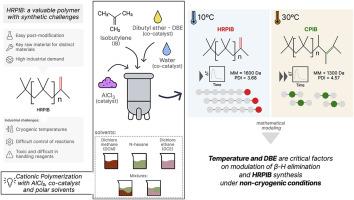Cationic polymerization of isobutylene by AlCl3 in polar solvents at mild temperatures
IF 4.5
2区 化学
Q2 POLYMER SCIENCE
引用次数: 0
Abstract
In the present study, adiabatic cationic polymerizations of isobutylene catalyzed by aluminum chloride were performed in different polar solvents (dichloromethane, dichloroethane and their mixtures with n-hexane), temperatures (10 °C and 30 °C) and concentrations of co-catalysts (water and dibutyl ether, DBE) to evaluate the respective impacts on the microstructure of the produced poly (isobutylene) (PIB). Reactions performed at 30 °C were characterized by quick heat release, fast polymerization kinetics and production of PIB samples with low average molar masses (<1300 Da), high polydispersities (4.57) and up to 25.7 mol% of vinyl content (conventional PIB, CPIB). On the other hand, reactions performed at 10 °C and with higher concentration of DBE provided highly reactive PIB (HRPIB) (vinyl content of 71.8 mol%) with low average molar masses (around 1600 Da) and lower polydispersity (3.68). Empirical mathematical modeling showed that temperature and DBE concentration exerted the most significant influences on vinyl content and molar mass, suggesting that these parameters can be used to modulate β-H elimination in the cationic polymerization of PIB towards the synthesis of conventional or HRPIB at non cryogenic temperatures.


极性溶剂中AlCl3阳离子聚合异丁烯的研究
本研究在不同极性溶剂(二氯甲烷、二氯乙烷及其与正己烷的混合物)、温度(10℃和30℃)和共催化剂浓度(水和二丁基醚,DBE)下,用氯化铝催化异丁烯的绝热阳离子聚合,以评价各自对所制聚异丁烯(PIB)微观结构的影响。在30℃下进行的反应具有热释放快、聚合动力学快、制备的PIB样品具有低平均摩尔质量(<1300 Da)、高多分散度(4.57)和高达25.7 mol%的乙烯基含量(传统PIB, CPIB)。另一方面,在10℃和较高浓度的DBE条件下,反应得到高活性的PIB (HRPIB)(乙烯基含量为71.8 mol%),平均摩尔质量低(约1,600 Da),多分散性低(3.68)。经验数学模型表明,温度和DBE浓度对乙烯基含量和摩尔质量的影响最为显著,表明这些参数可以调节PIB阳离子聚合过程中β-H的消除,从而在非低温条件下合成常规或HRPIB。
本文章由计算机程序翻译,如有差异,请以英文原文为准。
求助全文
约1分钟内获得全文
求助全文
来源期刊

Polymer
化学-高分子科学
CiteScore
7.90
自引率
8.70%
发文量
959
审稿时长
32 days
期刊介绍:
Polymer is an interdisciplinary journal dedicated to publishing innovative and significant advances in Polymer Physics, Chemistry and Technology. We welcome submissions on polymer hybrids, nanocomposites, characterisation and self-assembly. Polymer also publishes work on the technological application of polymers in energy and optoelectronics.
The main scope is covered but not limited to the following core areas:
Polymer Materials
Nanocomposites and hybrid nanomaterials
Polymer blends, films, fibres, networks and porous materials
Physical Characterization
Characterisation, modelling and simulation* of molecular and materials properties in bulk, solution, and thin films
Polymer Engineering
Advanced multiscale processing methods
Polymer Synthesis, Modification and Self-assembly
Including designer polymer architectures, mechanisms and kinetics, and supramolecular polymerization
Technological Applications
Polymers for energy generation and storage
Polymer membranes for separation technology
Polymers for opto- and microelectronics.
 求助内容:
求助内容: 应助结果提醒方式:
应助结果提醒方式:


